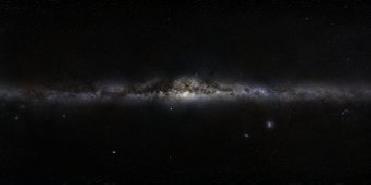
This magnificent 360-degree panoramic image, covering the entire southern and northern celestial sphere, reveals the cosmic landscape that surrounds our planet. Image Credit: ESO
PARIS (BNS): Stargazers eager to explore and experience the vast Universe can now feast on one of the three images released by European Southern Observatory�s GigaGalaxy Zoom project providing a 360-degree panoramic view of the magnificent night sky.
The image, captured from ESO�s observing sites in Chile, has been released online. The 360-degree panoramic image, covering the entire celestial sphere, reveals the cosmic landscape that surrounds our tiny blue planet, the organisation said.
The extremely-high resolution image is a part of the GigaGalaxy Zoom project, launched by ESO within the framework of the International Year of Astronomy 2009. The project features a web tool, enabling users to take a breathtaking dive into the Milky Way Galaxy.
The image is the result of a collaboration between the ESO, renowned French writer and astro-photographer Serge Brunier and his fellow Frenchman Fr�d�ric Tapissier.
Brunier spent several weeks between August 2008 and February 2009 capturing the sky, mostly from ESO observatories at La Silla and Paranal in Chile. In order to cover the full Milky Way, he also made a week-long trip to La Palma, one of the Canary Islands, to photograph the northern skies.
Once the raw photographs were in hand, image processing by Tapissier and ESO experts helped to convey accurately the night sky as our eyes behold it. The resulting image, now available on GigaGalaxy Zoom, is composed of almost 300 fields each individually captured by Brunier four times, adding up to nearly 1200 photos that encompass the entire night sky, the ESO said in a statement.
�I wanted to show a sky that everyone can relate to � with its constellations, its thousands of stars, with names familiar since childhood, its myths shared by all civilisations since Homo became Sapiens,� Brunier said. �The image was therefore made as man sees it, with a regular digital camera under the dark skies in the Atacama Desert and on La Palma,� he added.
As capturing the awe-inspiring images extended over several months, objects from the Solar System, including bright planets such as Venus and Jupiter, passed by the star fields.
The ESO will release the second dramatic GigaGalaxy Zoom image next week on September 21.
 Previous Article
Previous Article Next Article
Next Article












The Indian Air Force, in its flight trials evaluation report submitted before the Defence Ministry l..
view articleAn insight into the Medium Multi-Role Combat Aircraft competition...
view articleSky enthusiasts can now spot the International Space Station (ISS) commanded by Indian-American astr..
view article